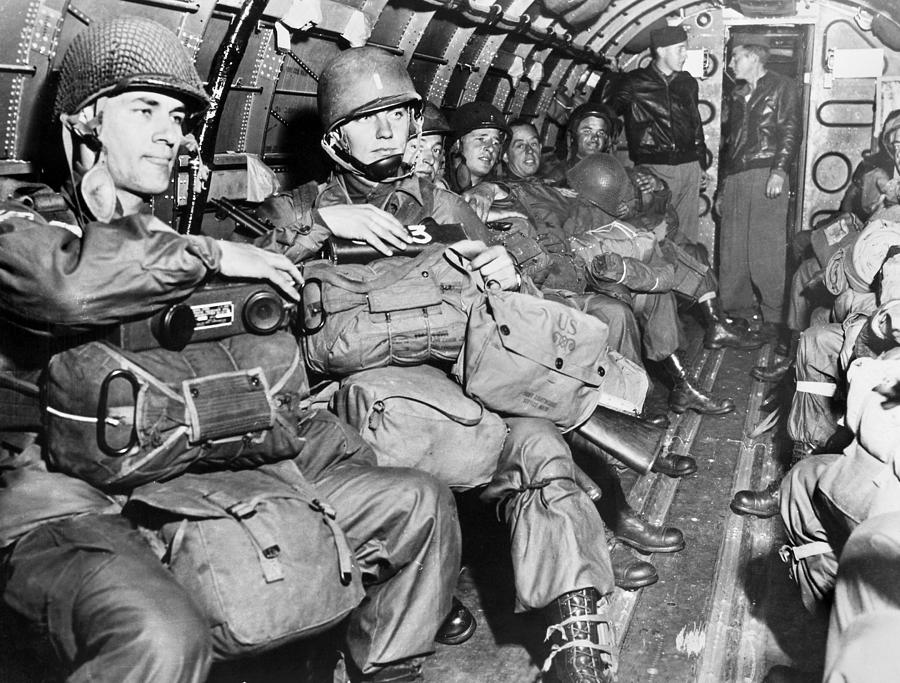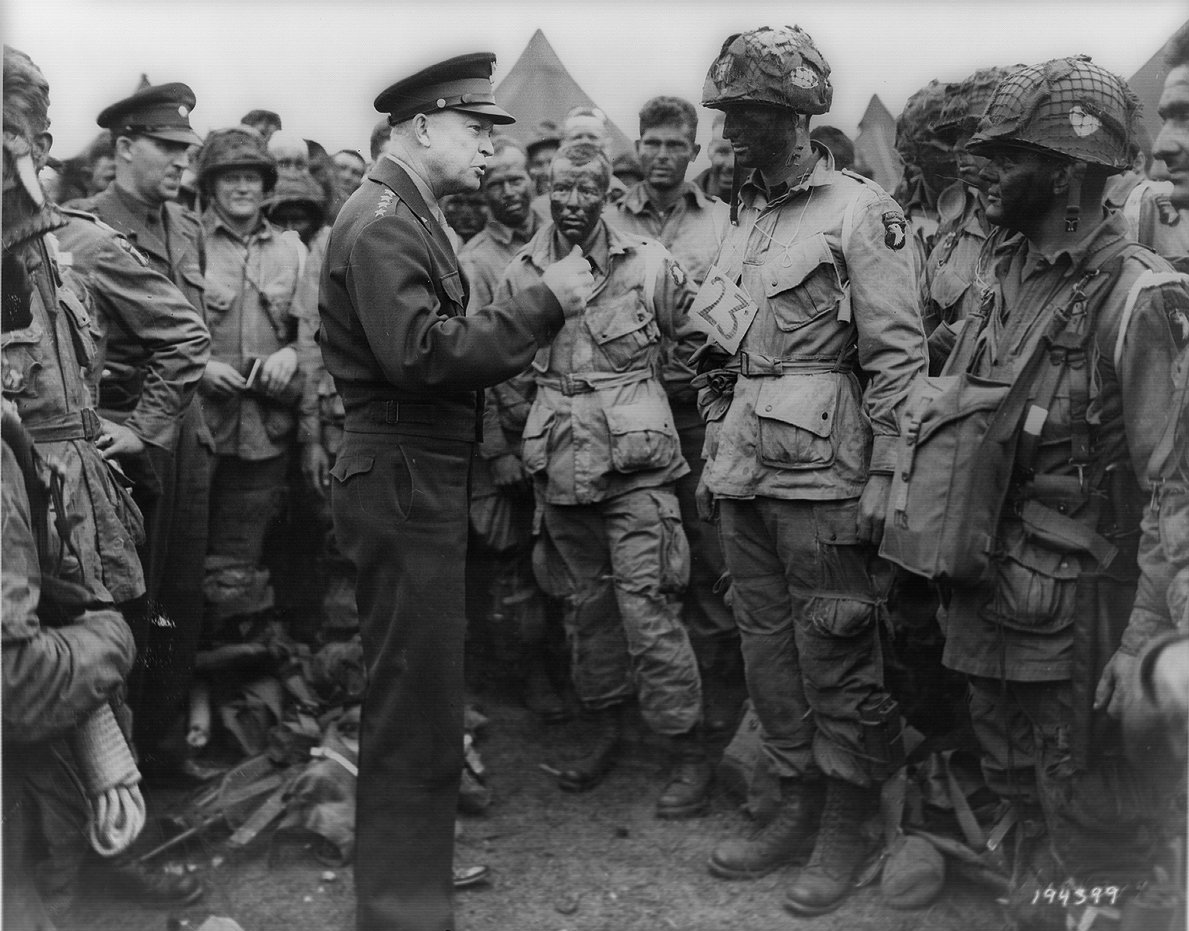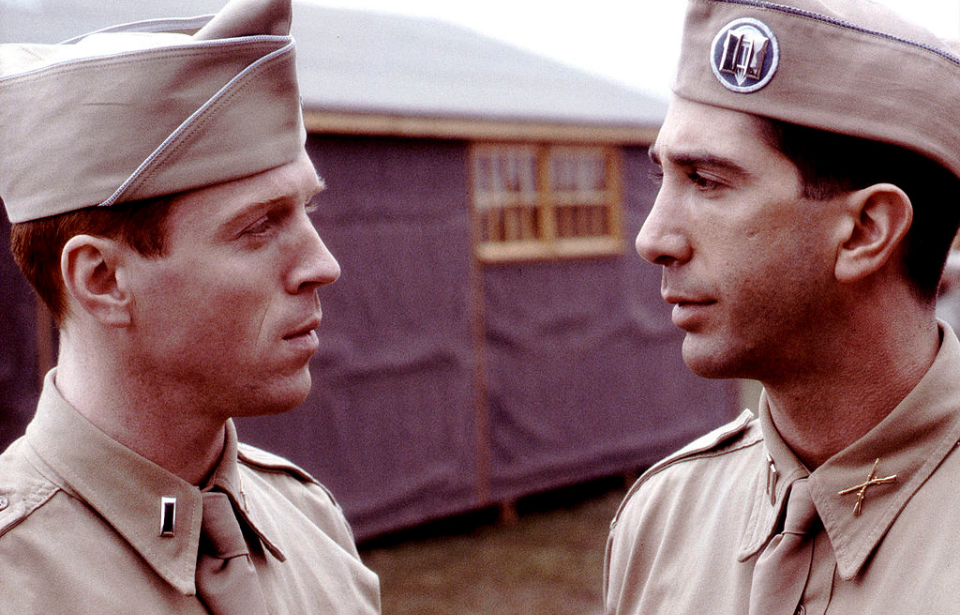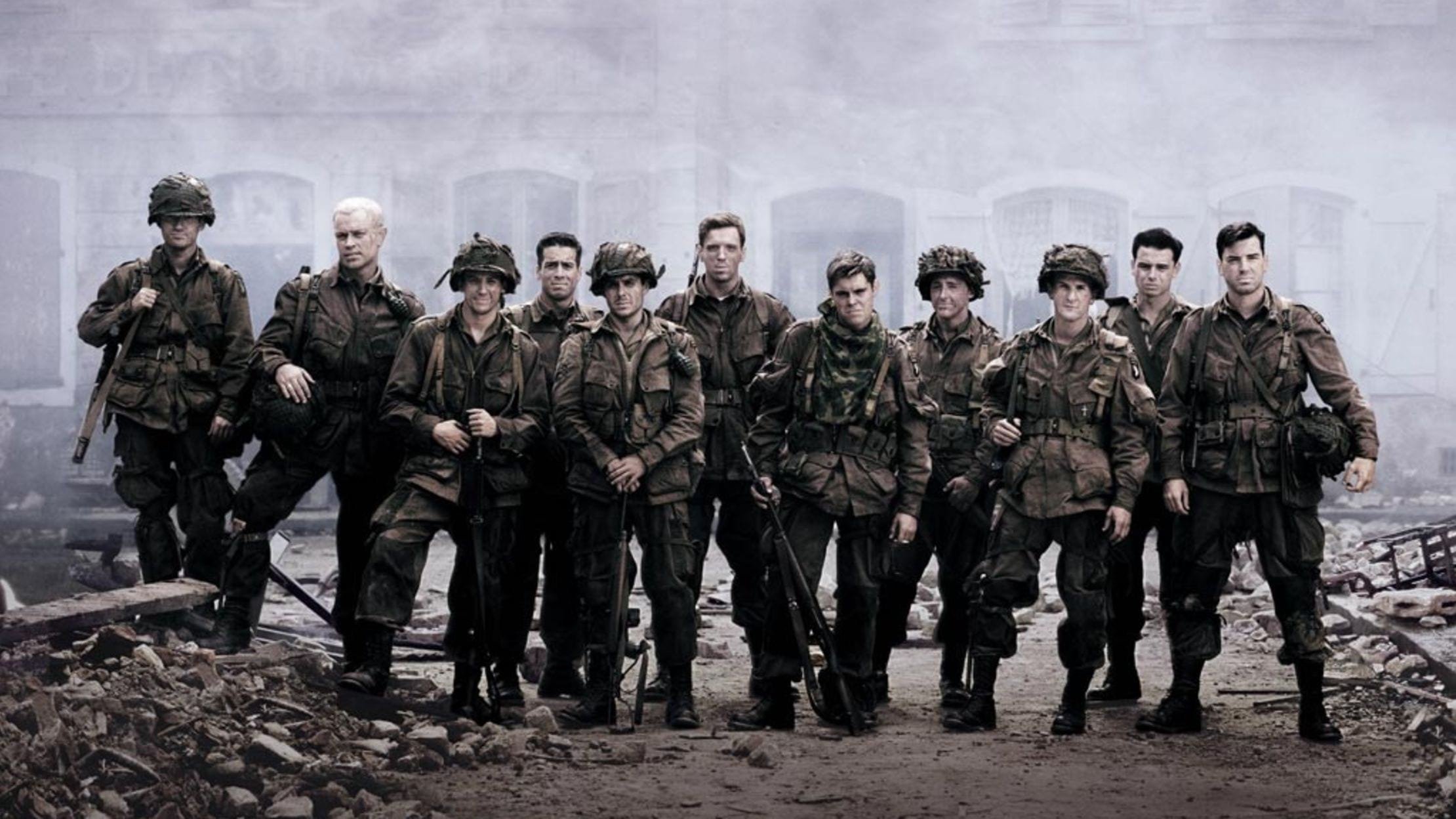When I was 13 years old, I found an old set of DVDs in my parent’s living room cabinet in a metal box with the title “Band of Brothers” enshrined on the front. I looked at the front cover. A group of soldiers stood in the destroyed ruins of a city, some talking to each other and others staring forward, but all of their faces were darkened so that I could not see them. Underneath the front cover was the phrase, “they depended on each other when the world depended on them.”
This was my introduction to the HBO miniseries Band of Brothers. Directed by Steven Spielberg and Tom Hanks, the series was adapted from Stephen E. Ambrose’s book with the same title. It covers the story of Easy Company, a unit of American paratroopers within the 101st Airborne Division that fought from the D-Day invasion of France to the war’s end. This article is a review of this miniseries, but two future articles will be written covering what I like to call “HBO’s War Epics.” These will be The Pacific and Generation Kill.
I found all three series to be beautiful and haunting in their own way, and they greatly changed my perspective on military conflict, the pain and suffering undergone by military veterans, and how to cope with the horrors of armed struggle. I will give my perspectives and reviews of the three films. I hope that if you haven’t already, you give the three of these series a watch because each one has its unique appeal to different audiences.

The Prologue: Ambrose’s Story and Historical Background
Stephen Ambrose had established his career as a respected historical writer and biographer of figures such as Richard Nixon and Dwight Eisenhower. However, when he visited New Orleans to attend a veterans memorial for members of the American 101st Airborne Division, he was intrigued by their story. After talking to surviving members and their families, he elected to write a book using oral accounts of the events to guide his writing.
In 1942, in response to the use of airborne troops by Nazi Germany, the US Army mandated the creation of two airborne divisions (about 10,000 men each) to be trained in the art of parachute operations. These troops would be trained to jump out of aircraft flying at low altitudes to take enemy territory quickly in a manner that was impossible for conventional infantry. Rather than attempting to break through enemy lines head-on, the U.S Army would send in the paratroopers to attack the enemy’s rear which would be lightly defended.
The 82nd Airborne and later 101st divisions were stood up by 1942, and training occurred in Fort Toccoa and Bragg in the southern United States. Paratroopers were held to a higher physical standard than conventional infantry troopers, and training included 5 full jumps from a C-47 Dakota aircraft. “Show me a man that will jump out of an airplane,” said US General James Gavin, “and I’ll show you a man that will fight!”

Paratroopers would then activate their parachutes and then they would glide toward the ground, being able to maneuver along the way. They would regularly jump with their equipment, which was numerous enough to ensure they could survive in hostile territory for days at a time. Alongside their parachute, their combined equipment weight would usually be close to 110 additional pounds.
“Show me a man that will jump out of an airplane, and I’ll show you a man that will fight!”
The 101st Airborne Division was nicknamed the ‘Screaming Eagles’ for their unit patch worn throughout the conflict. Their first commander, Major General William C. Lee, had this to say to the new troops:
“The 101st Airborne Division, which was activated on 16 August 1942, at Camp Claiborne, Louisiana, has no history, but it has a rendezvous with destiny.
Due to the nature of our armament, and the tactics in which we shall perfect ourselves, we shall be called upon to carry out operations of far-reaching military importance and we shall habitually go into action when the need is immediate and extreme. Let me call your attention to the fact that our badge is the great American Eagle. This is a fitting emblem for a division that will crush its enemies by falling upon them like a thunderbolt from the skies.
“The 101st Airborne Division has no history, but a rendezvous with destiny.”
The history we shall make, the record of high achievement we hope to write in the annals of the American Army and the American people, depends wholly and completely on the men of this division. Each individual, each officer and each enlisted man, must therefore regard himself as a necessary part of a complex and powerful instrument for the overcoming of the enemies of the nation. Each, in his own job, must realize that he is not only a means, but an indispensable means for obtaining the goal of victory. It is, therefore, not too much to say that the future itself, in whose molding we expect to have our share, is in the hands of the soldiers of the 101st Airborne Division.”

The Story
The story begins with one of Easy Company’s officers, Lieutenant Richard Winters conversing with his friend, fellow officer Lewis Nixon the night before the combined sea and airborne invasion on D-Day, June 6th on the Normandy beaches. The show takes a step back to the arduous training Easy Company endured at Camp Toccoa in the hills of Georgia.
The pilot episode recounts the ruthless Captain Sobel’s treatment of Easy Company. Training included 6-mile runs up and down Mount Currahee, which in Cherokee means “stand alone.” Sobel drilled Easy Company harder than any other parachute company in the 506th, and the initial bonds our characters forge are created out of spite towards Sobel. The initial characters that get to shine include Lieutenant Winters, who is portrayed as the opposite of Sobel. Winters replaces Sobel’s misplaced sense of superiority with a genuine care for his men, whilst still retaining Sobel’s high standards of training and distance from the rank and file. Winters quickly emerges as the narrator of the story.

The laid-back Lieutenant Nixon, a Yale graduate whose intelligence is easily apparent but whose leadership is not, also shows himself. The hard-swinging ‘Wild’ Bill Guarnere, reliable and conventional sergeants Lipton and Martin, the affectionate gentle giant Buck Compton, and more are introduced. All the characters will get their moment to shine later but the pilot episode, appropriately named “Currahee” gets us into the boots of the struggles of the paratroopers. Sobel eventually is replaced for his ineptitude at leadership (he was a better disciplinarian than a combat leader) and is replaced by Lieutenant Meehan.
“Currahee gets us into the boots of the struggles of the paratroopers.”
The rigorous training of Easy Company (and all American paratroopers of the time) put Allied command and their superior officers in awe. But everyone knew of the troubles that lay ahead in Normandy. “In a few hours I’m going to take the best company of men in the world into France,” wrote Easy Company’s new commanding officer Lieutenant Meehan, “and we’re going to give the bastards hell. Strangely I’m not particularly scared, but in my heart is a longing feeling to hold you in my arms.”
The second episode sees Easy Company drop behind enemy lines into Normandy, with an amazing jump scene with excellent effects given the 2001 release date. The following episodes cover the paratroopers’ journey through France, Holland, Belgium, and finally Germany. What makes each episode unique are that each one is written and produced by a different team of staff, making all of them unique with their own themes, cinematography, dialogue, and mood.

This is embodied by the fact that each episode covers its own “main character”, so for Episodes One and Two it’s Lieutenant Winters, but the following episodes follow the other members of this esteemed unit. It drives home the message that this was not just about one man, it was an entire unit of men suffering through the destructive conflict together.
The Score
No review of Band of Brothers is complete without discussing the opening theme. The opening of every episode alone is enough to center a section of the article around. The score, constructed by Michael Kamen, perfectly captures the somber environment our heroes find themselves in, while still retaining an uplifting feel of the inevitable Allied victory. At its core, it is an homage to the trials, tribulations, and triumphs of the men of Easy Company.
What makes the opening scene even more emotional is that every episode begins with interviews of surviving Easy Company veterans, who contribute to the overall narrative or theme of said episode. Hearing the authentic voices of Easy Company veterans, and then seeing their testimony be played out adds even more weight to the message Hanks and Spielberg were trying to push.
All of the tracks found in Band of Brothers are, in my opinion ultimately triumphant – they may begin with a despondent tone but they usually finish with some great or glorious bugle, trombone, or tuba announcing the victory of our heroes. It is a noticeably upbeat tone that will contrast the later production of series like Generation Kill and The Pacific.
The Characters
Like I said before, what I love about Band of Brothers is that each episode feels like its own movie. “Currahee” set the foundation for the characters and the themes of brother found throughout the show, but after that, nearly every character gets their time to shine, and a wide variety of interesting themes are delved into.
“every character gets their time to shine, and a variety of interesting themes are delved into.”
My personal favorites include Episode 4, “Replacements,” which delves into the story of rookie paratroopers who have arrived to replace Easy Company’s casualties before their second combat drop into the Netherlands, and Episode 8, “The Last Patrol,” which is dominated by the troubles of Private Webster and Lieutenant Jones (who alongside Lieutenant Speirs are my favorite characters from the show) in returning to Easy Company as an injured veteran who missed out on the unit’s worst battles and a rookie officer getting acclimated to the battlefield.

The collective trauma experienced by the men of Easy Company bonds them tightly as a unit. Whether it be Captain Sobel’s training regimen or the hellfires of combat, the men grow close to each other in ways that are impossible to replicate in any other circumstance. An element of this is that the leadership in Easy Company was, for the most part, excellent.
In any rifle company, the leadership is comprised of officers, such as the Captain, his executive officer, and four lieutenants each commanding a platoon. The US Army trained its officers in months of command and control, communications, direct action, and administrative duties, but because officer training didn’t require any experience, sometimes an officer would be placed in command of an entire platoon (nearly 40 riflemen) without ever having seen combat.
However, due to the higher standards of the paratroopers, Easy Company did have excellent officers such as Lieutenant Winters, Welsh, Jones, Meehan and Malarkey. Winters noticeably provides repeated examples of truly great leadership, a selfless officer who leads by example yet balances this with a willingness to distance himself from his men to retain their consistent respect. One of my favorite scenes from the entire show is when Private Blithe repeatedly professes his fear of combat to multiple separate officers in Episode 3, “Carentan”. Each officer (Lieutenant Welsh, Speirs, and finally Winters) displays their own unique leadership style by attempting to encourage the frightened paratrooper.

But another source of leadership in Easy Company came from its NCOs or non-commissioned officers. These were men who were in command positions lower than officers but were only in that position because of their experience in the field. While acting as an intermediary between officers and enlisted personnel, NCOs also would take the position of officers should the latter be killed or wounded. As Easy Company veteran Lester Hashey put it, “We had some bad officers, but we had excellent NCOs.”
By the end of the war, Easy Company was not the same company that had dropped into Normandy 11 months before. Many of its members had been killed or wounded, and nearly half of the company were replacements who had little to no chemistry with the older veterans. The angst between the older members of the unit and the shiny replacements that followed them is on full display from Episode Four onwards.
The final two episodes cover the paratroopers’ occupation of Germany, which tragically became just as dangerous as their earlier battles. Troopers are killed in traffic accidents and drinking sprees. As the now Major Winters puts it, “My men were still dying months after we last saw combat.” The series ends with Winters recollecting on the eventual fates of the surviving “Toccoa” men of Easy Company, those who started out with the unit going back to D-Day.
“Each of us would be forever connected from our shared experience, and each would have to rejoin the world as best we could.” – Major Winters
“Each of us would be forever connected from our shared experience, and each would have to rejoin the world as best we could,” said Major Winters at the end of the series. “There is not a day that goes by that I do not think of the men I served with, who never got to enjoy the world without war.”

Conclusion
One aspect that will be covered in all three reviews of HBO’s war epics is the post-war experience. Despite the terror, the agony, and the chaos war imposed on these young men, some of them had grown accustomed to it and were unfamiliar with the peace of civilian life. Easy Company veteran Darrell “Shifty” Powers commented that “it seemed that you could do just about anything, and when the war was over and you came back home you lost a lot of that. I did, I lost a lot of that confidence.”
For Band of Brothers, the struggles of returning back home after some of the harshest fighting in the war are mentioned only a few times, and we never actually see the men return home. However, I think the veteran accounts at the beginning of each episode, as well as the final two shows, give us the necessary account of the struggles of the veterans as they return home.
Band of Brothers was the first major TV series I have watched that centered on war. I was – and still am – enamored by the stories of Easy Company. Being the first series produced by both Hanks and Spielberg, Band of Brothers’ 2001 release date arrived at a time when America was threatened with global terrorism and international instability. The uplifting tale of Band of Brothers, that each individual’s valor contributed to the success of the unit as a whole, was a welcome reminder to America of what can be accomplished when ordinary men are asked to do extraordinary things.

